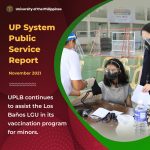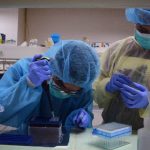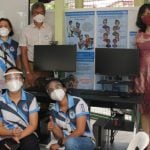This Monthly Bulletin highlights the different COVID-19 responses of the eight UP Constituent Universities and their involvement in various public service initiatives during the pandemic. It features the UP System Report on the CUs’ public service initiatives from November 1-30.
Author: Padayon UP
Saloma said that they need backtrack samples from early November as well as other samples arriving in the Philippines. This also includes positive samples from the airport and from different places in the country so that they can conduct more intense sequence, Saloma explained.
The PGH Department of Obstetrics and Gynecology launched its new unit, the first of its kind in the country, the Division of Sexual Health (DSH) on November 29 to promote wellness and address pathologic conditions on sexual and reproductive health.
The Philippine General Hospital-Hospital Infection Control Unit (PGH-HICU) has recommended on Saturday, Nov. 27, an open-air setup for Christmas parties and year-end events.
In its released guideline, PGH-HICU said that while virtual programs are preferred, face-to-face Christmas parties can be held in rooms where the doors and windows can be opened up to maintain good air circulation.
For the University of the Philippines (UP), volunteerism is crucial in nurturing civic engagement and strengthening community spirit among UP students and their partners. With COVID-19, students may now organize meaningful volunteering projects with safety and program concerns in place.
UP’s public service conference highlights Bayanihan, compassion, hope, and trust during the pandemic
The UP Padayon Public Service Office held this year’s CUPSCon on October 21, 2021, via online platforms. The purpose of this conference was to share information with the attendees on the best practices and challenges that come with public service and the direction where future public service is heading.
“Ang sina-suggest nga namin, baka puwedeng i-consider ito after na ng holidays, January. I-ready muna natin ‘yong society,” ani Jomar Rabanjante ng University of the Philippines COVID-19 Pandemic Response Team.
Sa ilalim kasi ng Alert Level 1, puwede na ang 100 porsiyentong kapasidad sa mga establisimyento basta mapapanatili ang pagsunod sa health protocols, bagay na ngayon pa lang sa Alert Level 2 ay hirap nang sundin ng ilan.
“NCR is not an island. May kalapit siyang Region 4-A, Region 3. Actually ‘yong mga kalapit-bayan niya, hindi pa kasingtulad ng NCR ang vaccine coverage,” ani Rabanjante.
The Swerve tool is developed by DoST-Pagasa under the program Severe Wind Hazard and Risk Assessment for Cebu City in collaboration with the Philippine Institute of Volcanology and Seismology and the University of the Philippines Diliman-Institute of Civil Engineering. This innovation is used for the impact assessment of severe wind hazard due to tropical cyclones for the target local government unit, Cebu City.
Timbal explained that with the Swerve tool, users can access data on the impact of severe wind hazards, caused by typhoons from the provincial level down to the barangay (village) level. In doing so, this can be a big help to LGU officials, disaster managers and planners to improve their mitigation strategies and develop more effective action plans to be implemented in their respective areas and lessen the impact of this natural hazard.
The Child Protection Network (CPN) Foundation and UNICEF swiftly responded by developing a new system to ensure that child protection services are continued despite the restrictions of the pandemic— the TeleCPUs in the Barangay. Through telemedicine and 39 barangay-based teleCPU satellites, abused children can go to the nearest barangay and have access to teleconsultation and specialty services available only in tertiary care centers.
In relation to its continued webinars and upskilling programs for faculty members on the use of the Learning Management System, last August 19, 2021, TLRC conducted “sana oL May high Score” training that delved into the utilization of the LMS gradebook in order for teachers to provide an efficient and systematic feedback system for assignments and other requirements of students.





